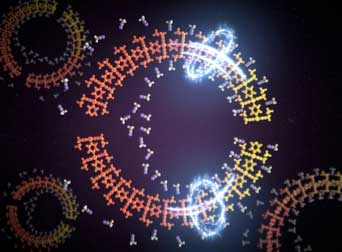| Jul 15, 2019 | |
Reversible electro-optical detector for environmental sensing of pollutants(Nanowerk News) The increasing emissions of volatile organic compounds (VOCs) and their resulting impact on air and water quality has become one of the major environmental concerns of our age, especially in industrialized societies. |
|
| Some VOCs are identified as highly toxic or carcinogenic and may cause impact on human health as well as on the natural ecosystem. VOCs are emitted from the use of many everyday household products which makes the control of their emissions particularly difficult and critical. | |
| One of these VOCs is acetonitrile, which is primary used as an organic solvent in extractive processes, and it is also commonly used for dyeing textiles, as a metal cleaner and for battery applications. | |
| Exposure to acetonitrile occurs mainly through inhalation and dermal contact in workplaces in which acetonitrile is produced or used, due to its high volatility. Toxicological studies have provided sufficient evidence that high levels of acetonitrile induce potential neurotoxicity, nausea, impaired motor activity, shallow and/or irregular respiration and, in extreme cases, death. | |
| Currently, highly sensitive analytical techniques are employed for the accurate quantification of VOCs, often based on optical absorption, particle counting or mass spectrometry. However, these techniques display some drawbacks, such as their low portability, constrained selectivity, complex and time consuming pre-treatment steps, necessity of highly skilled operators and high cost. | |
| To overcome these limitations and explore more cost effective alternatives such coordination polymers have attracted a great deal of attention in the development of next-generation sensing devices. These materials, can host VOCs through a process of diffusion throughout the crystal lattice. This process may produce an easy-to-measure response due to the variation of the properties of these materials, in agreement with the definition of chemosensor. | |
 |
|
| Coordination polymer as an acetonitrile sensor. (Image: Scixel) | |
| Specifically, these chemosensors could display an easily detectable change in almost any physicochemical property, such as in the luminescent emission, the electrical conductivity, the magnetic behavior and even a naked-eye color change. | |
| The groups of Prof. Enrique Burzurí and Prof. J. Sanchez Costa at IMDEA Nanociencia propose the use of a simple non-porous coordination polymer that shows a magneto-structural transition under desorption/absorption of acetonitrile molecules in the structure (Chemical Science, "A switchable iron-based coordination polymer toward reversible acetonitrile electro-optical readout "). | |
| This reversible change produces a measurable response in the presence of acetonitrile. This response comes in the form of a change in the color of the polymer from orange to yellow and an abrupt increase in the electrical conductivity. | |
| Both of these responses are easily observed by the naked-eye or easily measured, providing an obvious advantage from the highly costly analytical techniques. Moreover, these responses occur at well-defined temperatures close to ambient conditions. Today, as far as we know, this is the first example of a molecule-based material that shows all this macroscopic readable properties all in once. | |
| This research is the result of the collaboration between IMDEA Nanociencia groups and has been funded by the European Commission (MSCA-IF), the Spanish Ministry of Economy and Competitiveness (Ramón y Cajal), the Regional Government of Comunidad de Madrid, as well as the national Severo Ochoa Program of Excellence. The authors acknowledge the XALOC-ALBA Synchrotron (Barcelona) and the Advanced Light Source (Berkeley). |
| Source: IMDEA | |
|
Subscribe to a free copy of one of our daily Nanowerk Newsletter Email Digests with a compilation of all of the day's news. |
